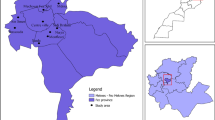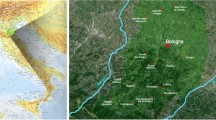Abstract
Allium siculum Ucria is a perennial bulbous plant that occurs in Bulgaria as A. siculum subsp. dioscoridis (Sm.) K. Richt. The plant is locally known as “samardala”. Its herbage is used traditionally by local communities in Bulgaria as edible green and for preparation of salty spice mixtures. The study was focused on the documentation of traditional knowledge about samardala, covering local collection and cultivation practices, processing methods and consumption preferences. The respondents (aged 30–86 years, 50% over 65) were local producers and small-scale salesmen of the herbage and samardala-containing spices. To assess the health features of samardala spices the total phenol and flavonoid content was measured in home-consumed or marketed flavoured salts. Overall appreciation of the plant and related food products was found to be very high; presenting a considerable engagement of the locals in plant cultivation and gathering, laborious processing and consumption. Traditional ecological knowledge about the biology, phenology and ecology of the samardala plant and methods for its processing is still preserved by elderly people who rely mostly on their own cultivated plants. Although the introduction of modern appliances has altered the method of production, its main stages and the recipes are preserved. Modernization of the processing method has not affected the quality of the products and faster processing could be a contributing factor for the higher content of biologically active substances. Phenolic content was about twice as low as the flavonoid content, following the same pattern for all tested flavoured salts. Measures for better management of natural populations and promotion of cultivation practices of A. siculum subsp. dioscoridis would ensure the sustainable quality of traditional products as well as conservation of the natural plant resources.



Similar content being viewed by others
References
Ahtarov B, Davidov B, Yavashev A (1939) Materials for the Bulgarian botanical glossary. Royal Court Printing House, Sofia (in Bulgarian)
Alexieva I, Mihaylova D, Popova A (2013) Evaluation of the antioxidant capacity of aqueous extracts of fresh Samardala (Allium bulgaricum L.) leaves. Sci Works 60:826–831
Ceschmedziev I, Neykov S (1999) Biodiversity, distribution, preservation of Allium spp. in Bulgaria. In: Maggioni L, Astley D, Rabinowitch H, Keller J, Lipman E. (eds) Report of a working group on Allium, sixth meeting, 23–25 October 1997, Plovdiv, Bulgaria. International Plant Genetic Resources Institute, Rome, Italy, pp 80–82
Chakarova-Krasteva N (2002) Folk medical treatments as remembered and practiced by people of Karnobat region. In: Goev A (ed) Ethnological studies v. IV, Faber, V. Tarnovo, pp 46–52 (in Bulgarian)
Davis PH (ed) (1984) Flora of Turkey and the East Aegean Islands, vol 8. Edinburgh University Press, Edinburgh, pp 1–632
Delipavlov D, Cheshmedzhiev I (eds) (2003) Key to the Plants of Bulgaria. Acad Press Agrar Univ, Plovdiv (in Bulgarian)
Dimitrov M, Tzonev R (2015) 05G1 Riparian and lowland mixed woodlands and longozes. In: Biserkov et al (eds) Red data book of the Republic of Bulgaria v. 3 Habitats, pp 281–284. http://e-ecodb.bas.bg/rdb/en/vol3/05G1.html
Fedorov A (ed) (1979) Flora of European parts of USSR, vol 4. Nauka, Leningrad (in Russian)
Gouveia S, Castilho PC (2011) Characterisation of phenolic acid derivatives and flavonoids from different morphological parts of Helichrysum obconicum by a RP-HPLC–DAD-(−)–ESI-MSn method. Food Chem 129(2):333–344. https://doi.org/10.1016/j.foodchem.2011.04.078
Hwang JS et al (2015) Total phenolics, total flavonoids, and antioxidant capacity in the leaves, bulbs, and roots of Allium hookeri. Kor J Food Sci Technol 47(2):261–266. https://doi.org/10.9721/KJFST.2015.47.2.261
International Society of Ethnobiology (ISE) (2008) The ISE code of ethics. http://www.ethnobiology.net/what-we-do/core-programs/iseethics-program/code-of-ethics/
Kamenetsky R, Fritsch RM (2002) Ornamental alliums. In: Rabinowitch H, Currah L (eds) Allium crop science: recent advances. CABI Publishing, Wallingford. https://doi.org/10.1079/9780851995106.0000
Kubec R et al (2002) Isolation of S-n-butylcysteine sulfoxide and six n-butyl-containing thiosulfinates from Allium siculum. J Nat Prod 65(7):960–964. https://doi.org/10.1021/np020064i
Kubec R et al (2010) Applications of direct analysis in real time-mass spectrometry (DART-MS) in Allium chemistry. (Z)-Butanethial S-oxide and 1-butenyl thiosulfinates and their S-(E)-1-butenylcysteine S-oxide precursor from Allium siculum. J Agric Food Chem 58(2):1121–1128. https://doi.org/10.1021/jf903733e
Kusterer J, Keusgen M (2009) Cysteine sulfoxides and volatile sulfur compounds from Allium tripedale. J Agric Food Chem 58(2):1129–1137. https://doi.org/10.1021/jf903581f
Lanzotti V (2006) The analysis of onion and garlic. J Chrom A 1112(1):3–22. https://doi.org/10.1016/j.chroma.2005.12.016
Leonti M, Nebel S, Rivera D, Heinrich M (2006) Wild gathered food plants in the European Mediterranean: a comparative analysis. Econ Bot 60(2):130–142. https://doi.org/10.1663/0013-0001(2006)60[130:WGFPIT]2.0.CO;2
Luczaj L et al (2012) Wild food plant use in 21st century Europe, the disappearance of old traditions and the search for new cuisines involving wild edibles. Acta Soc Bot Pol 81(4):359–370
Łuczaj Ł et al (2013) Wild edible plants of Belarus: from Rostafiński’s questionnaire of 1883 to the present. J Ethnobiol Ethnomed 9(1):21. https://doi.org/10.1186/1746-4269-9-21
Marinov Y et al (2016) Reports 76–89 In: Vladimirov et al (eds) New floristic records in the Balkans: 30. Phyt Balk 22(2):259–292. http://www.bio.bas.bg/~phytolbalcan/PDF/22_2/contents.html
McDonald S, Prenzler PD, Antolovich M, Robards K (2001) Phenolic content and antioxidant activity of olive extracts. Food Chem 73(1):73–84. https://doi.org/10.1016/S0308-8146(00)00288-0
Menendez-Baceta G et al (2012) Wild edible plants traditionally gathered in Gorbeialdea (Biscay, Basque Country). Genet Resour Crop Evol 59(7):1329–1347. https://doi.org/10.1007/s10722-011-9760-z
Miean KH, Mohamed S (2001) Flavonoid (myricetin, quercetin, kaempferol, luteolin, and apigenin) content of edible tropical plants. J Agric Food Chem 49(6):3106–3112. https://doi.org/10.1021/jf000892m
Mihaylova K (2013) Labour migration of Bulgarians to the Czech lands and some aspects of their ethnocultural identity. Ethnogr Ethnol Anthropol Cult 2:57–72
Mitić-Ćulafić D et al (2016) Effect of Allium flavum L. and Allium melanantherum Panč. Extracts on oxidative DNA damage and antioxidative enzymes superoxide dismutase and catalase. Plant Foods Hum Nutr (Dordrecht, Netherlands) 71(1):28–34. https://doi.org/10.1007/s11130-015-0519-0
Nedelcheva A (2013) An ethnobotanical study of wild edible plants in Bulgaria. EurAsian J BioSci 7:77–94. https://doi.org/10.5053/ejobios.2013.7.0.10
Ninfali P, Mea G, Giorgini S, Rocchi M, Bacchiocca M (2005) Antioxidant capacity of vegetables, spices and dressings relevant to nutrition. Brit J Nutr 93(2):257–266. https://doi.org/10.1079/BJN20041327
Pardo-de-Santayana M et al (2007) Traditional knowledge on wild edible plants in the northwest of the Iberian Peninsula (Spain and Portugal): a comparative study. J Ethnobiol Ethnomed 3:27. https://doi.org/10.1186/1746-4269-3-27
Pérez-Gregorio RM et al (2010) Identification and quantification of flavonoids in traditional cultivars of red and white onions at harvest. J Food Comp Anal 23(6):592–598. https://doi.org/10.1016/j.jfca.2009.08.013
Pieroni A (2008) Local plant resources in the ethnobotany of Theth, a village in the Northern Albanian Alps. Genet Resour Crop Evol 55(8):1197–1214
Pieroni A, Sõukand R (2017) The disappearing wild food and medicinal plant knowledge in a few mountain villages of North-Eastern Albania. J Appl Bot Food Qual 90:58–67. https://doi.org/10.5073/JABFQ.2017.090.009
Pieroni A, Nebel S, Santoro RF, Heinrich M (2005) Food for two seasons: culinary uses of non-cultivated local vegetables and mushrooms in a south Italian village. Int J Food Sci Nutr 56(4):245–272. https://doi.org/10.1080/09637480500146564
Pieroni A et al (2017) Traditional food uses of wild plants among the Gorani of South Kosovo. Appetite 108:83–92. https://doi.org/10.1016/j.appet.2016.09.024
Popova A, Mihaylova D, Alexieva I (2014) Comparative study on the antioxidant activity of selected culinary plants growing in Bulgaria. Int J Curr Microbiol App Sci 11(3):436–444
Simkova K, Polesny Z (2015) Ethnobotanical review of wild edible plants used in the Czech Republic. J Appl Bot Food Qual 88(1):49–67. https://doi.org/10.5073/JABFQ.2015.088.009
St Valev (1964) Nectaroscordum Lindl. In: Jordanov D (ed) Flora of Bulgaria, vol 2. Izd Bul Acad Sci, Sofia, pp 246–247 (in Bulgarian)
Stojanov N, Kitanov B (1960) Wild and useful plants in Bulgaria. BAS Publ, Sofia (in Bulgarian)
Stojanov N, Stefanov B (1824) Flora of Bulgaria, part 1. Darjavna pechatnitsa, Sofia (in Bulgarian)
Stranski I (1963) Wild and cultivated plants in Bulgaria. BAS Publ, Sofia (in Bulgarian)
Tardío J (2010) Spring is coming: the gathering and consumption of wild vegetables in Spain. In: Pardo-de-Santayana M, Pieroni A, Puri R (eds) Ethnobotany in the New Europe: people, health and wild plant resources. Berghahn Books, Oxford-New York, pp 211–238
Tutin TG (eds) (1980) Flora Europaea 5: 1-452. Cambridge University Press
Velíšek J et al (1997) Chemical composition and classification of culinary and pharmaceutical garlic-based products. Z Lebensmittelforschung A 204(2):161–164. https://doi.org/10.1007/s002170050054
Acknowledgements
This study is funded by Ministry of Education and Science under Grant No. DFNI K02/16 “Transformations of Local Agricultural Practices under Conditions of Europeanization and Globalization”. Work of T. Ivanova is supported by the Program for career development of young scientists, Bulgarian Academy of Sciences (Grant No. 69/2016). Authors are grateful to all respondents and their families for sharing their knowledge for this study and dedicate this paper to the loving memory of two of our most resourceful contributors Rada Mihaylova and Todor Chaparov.
Author information
Authors and Affiliations
Corresponding author
Ethics declarations
The ethical guidelines prescribed by the International Society of Ethnobiology were followed.
Conflict of interest
The authors declare that they have no conflict of interest.
Rights and permissions
About this article
Cite this article
Ivanova, T., Chervenkov, M., Stoeva, T. et al. Samardala: specificities and changes in the ethnobotanical knowledge about Allium siculum subsp. dioscoridis (Sm.) K. Richt. in Bulgaria. Genet Resour Crop Evol 65, 1349–1357 (2018). https://doi.org/10.1007/s10722-018-0618-5
Received:
Accepted:
Published:
Issue Date:
DOI: https://doi.org/10.1007/s10722-018-0618-5




